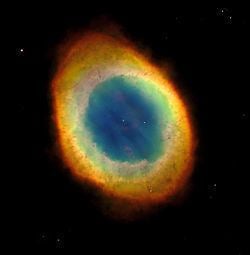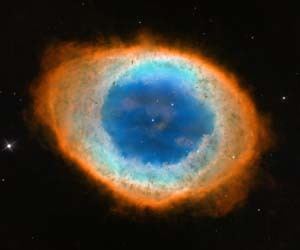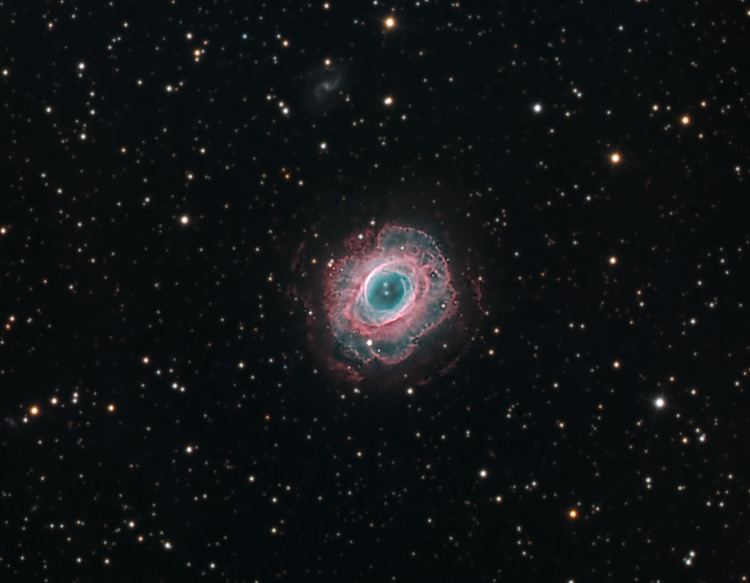Right ascension 18 53 35.079 Apparent dimensions (V) 230″ × 230″ Distance to Earth 2,283 light years | Declination +33° 01′ 45.03″ Age 7,005 years Magnitude 8.8 Apparent magnitude (V) 8.8 | |
 | ||
Radius 7016122989496143550♠1.3+0.8−0.4 ly ly Absolute magnitude (V) 3000800000000000000♠−0.2+0.7−1.8 Designations M 57, NGC 6720, GC 4447. Coordinates RA 18h 53m 35s | Dec +33° 1′ 45″ Similar Dumbbell Nebula, Whirlpool Galaxy, Messier 13, Orion Nebula, Messier 56 | ||
Eots a guide to the ring nebula m57 6 23 6 29
The Ring Nebula (also catalogued as Messier 57, M57 or NGC 6720) is a planetary nebula in the northern constellation of Lyra. Such objects are formed when a shell of ionized gas is expelled into the surrounding interstellar medium by a red giant star, which was passing through the last stage in its evolution before becoming a white dwarf.
Contents
- Eots a guide to the ring nebula m57 6 23 6 29
- Ring nebula m57 deep sky videos
- History
- Observation
- Properties
- Nebula structure
- Planetary nebula nucleus PNN
- References

Ring nebula m57 deep sky videos
History

This nebula was discovered by the French astronomer Antoine Darquier de Pellepoix in January 1779, who reported that it was "...as large as Jupiter and resembles a planet which is fading". Later the same month, fellow French astronomer Charles Messier independently found the same nebula while searching for comets. It was then entered into his catalogue as the 57th object. Messier and German-born astronomer William Herschel speculated that the nebula was formed by multiple faint stars that were unresolvable with his telescope.

In 1800, German Count Friedrich von Hahn announced that he had discovered the faint central star at the heart of the nebula a few years earlier. He also noted that the interior of the ring had undergone changes, and said he could no longer find the central star. In 1864, English amateur astronomer William Huggins examined the spectra of multiple nebulae, discovering that some of these objects, including M57, displayed the spectra of bright emission lines characteristic of fluorescing glowing gases. Huggins concluded that most planetary nebulae were not composed of unresolved stars, as had been previously suspected, but were nebulosities. The nebula was first photographed by the Hungarian astronomer Eugene von Gothard in 1886.
Observation

Messier 57 is located south of the bright star Vega, which forms the northwestern vertex of the Summer Triangle asterism. The nebula lies about 40% of the distance from Beta (β) to Gamma (γ) Lyrae, making it an easy target for amateur astronomers to find.

The nebula disk has an angular size of 1.5 × 1 arcminutes, making it too small to be resolved with 10×50 binoculars. It is best observed using a telescope with an aperture of at least 20 cm (8 in), but even a 7.5 cm (3 in) telescope will reveal its elliptical ring shape. The interior hole can be resolved by a 10 cm (4 in) instrument at a magnification of 100×. Larger instruments will show a few darker zones on the eastern and western edges of the ring, and some faint nebulosity inside the disk. The central star, at magnitude 14.8, is difficult to spot.
Properties
M57 is 0.7 kpc (2,300 light-years) from Earth. It has a visual magnitude of 8.8v and photographic magnitude of 9.7p. Photographs taken over a period of 50 years show the rate of nebula expansion is roughly 1 arcsecond per century, which corresponds to spectroscopic observations as 20–30 km s−1. M57 is illuminated by a central white dwarf or planetary nebula nucleus (PNN) of 15.75v visual magnitude.
All the interior parts of this nebula have a blue-green tinge that is caused by the doubly ionized oxygen emission lines at 495.7 and 500.7 nm. These observed so-called "forbidden lines" occur only in conditions of very low density containing a few atoms per cubic centimeter. In the outer region of the ring, part of the reddish hue is caused by hydrogen emission at 656.3 nm, forming part of the Balmer series of lines. Forbidden lines of ionized nitrogen or [N II] contributes to the reddishness at 654.8 and 658.3 nm.
Nebula structure
M57 is an example of the class of planetary nebulae known as bipolar nebulae, whose thick equatorial rings visibly extend the structure through its main axis of symmetry. It appears to be a prolate spheroid with strong concentrations of material along its equator. From Earth, the symmetrical axis is viewed at about 30°. Overall, the observed nebulosity has been currently estimated to be expanding for approximately 7003161000000000000♠1610±240 years.
Structural studies find this planetary exhibits knots characterized by well developed symmetry. However, these are only silhouettes visible against the background emission of the nebula's equatorial ring. M57 may include internal N II emission lines located at the knots' tips that face the PNN; however, most of these knots are neutral and appear only in extinction lines. Their existence shows they are probably only located closer to the ionization front than those found in the Lupus planetary IC 4406. Some of the knots do exhibit well-developed tails which are often detectable in optical thickness from the visual spectrum.
Planetary nebula nucleus (PNN)
The central PNN was discovered by Hungarian astronomer Jenő Gothard on September 1, 1886, from images taken at his observatory in Herény, near Szombathely (now part of Szombathely). Within the last two thousand years, the central star of the Ring Nebula has left the asymptotic giant branch after exhausting its supply of hydrogen fuel. Thus it no longer produces its energy through nuclear fusion and, in evolutionary terms, it is now becoming a compact white dwarf star.
The PNN now consists primarily of carbon and oxygen with a thin outer envelope composed of lighter elements. Its mass is about 0.61–0.62 M☉, with a surface temperature of 7005125000000000000♠125000±5000 K. Currently it is 200 times more luminous than the Sun, but its apparent magnitude is only +15.75.
